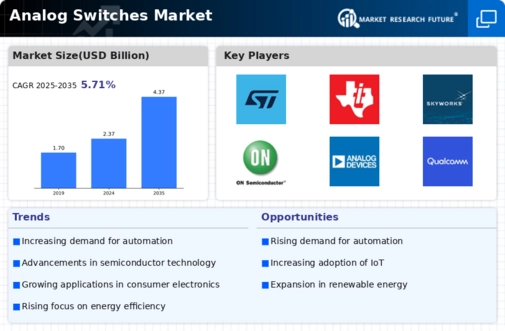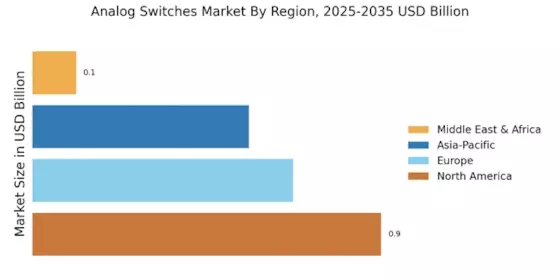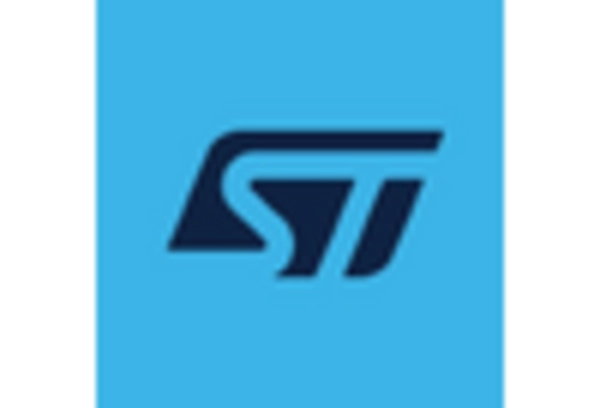Emergence of Smart Home Technologies
The Analog Switches Market is experiencing a transformative phase driven by the emergence of smart home technologies. As consumers increasingly adopt smart devices for home automation, the demand for reliable and efficient signal management solutions rises. In 2025, the smart home market is anticipated to exceed 150 billion USD, with analog switches playing a vital role in connecting various devices, such as smart thermostats, lighting systems, and security cameras. These components ensure seamless communication between devices, enhancing user experience and functionality. The growing trend towards home automation suggests a robust future for the Analog Switches Market, as manufacturers strive to meet the evolving needs of consumers seeking integrated smart home solutions.
Advancements in Automotive Technology
The Analog Switches Market is significantly influenced by advancements in automotive technology, particularly with the rise of electric vehicles (EVs) and autonomous driving systems. As the automotive sector evolves, the integration of sophisticated electronic systems necessitates reliable signal management solutions. In 2025, the automotive electronics market is expected to surpass 300 billion USD, with analog switches being essential for various applications, including infotainment systems, safety features, and battery management. The demand for high-performance analog switches is likely to increase as manufacturers seek to enhance vehicle functionality and safety. This trend underscores the pivotal role of analog switches in the automotive industry, suggesting a sustained growth trajectory for the Analog Switches Market.
Rising Demand for Consumer Electronics
The Analog Switches Market experiences a notable surge in demand driven by the increasing proliferation of consumer electronics. As devices such as smartphones, tablets, and wearables become ubiquitous, the need for efficient signal routing solutions intensifies. In 2025, the consumer electronics sector is projected to reach a valuation of approximately 1 trillion USD, with analog switches playing a crucial role in enhancing device performance. These components facilitate seamless connectivity and signal integrity, which are paramount in modern electronic applications. Consequently, manufacturers are compelled to innovate and integrate advanced analog switches into their products, thereby propelling the growth of the Analog Switches Market. This trend indicates a robust future for analog switches as they become integral to the functionality of next-generation consumer devices.
Growth of Telecommunications Infrastructure
The Analog Switches Market is poised for growth due to the expansion of telecommunications infrastructure. As the demand for high-speed internet and reliable communication services escalates, telecommunications companies are investing heavily in upgrading their networks. In 2025, The Analog Switches Market is projected to reach approximately 2 trillion USD, with analog switches being integral to managing signal routing and ensuring optimal performance. These components facilitate the efficient operation of various network devices, including routers and switches, which are essential for maintaining connectivity. The increasing reliance on digital communication underscores the importance of analog switches, indicating a favorable outlook for the Analog Switches Market as it aligns with the broader trends in telecommunications.
Increased Focus on Renewable Energy Solutions
The Analog Switches Market is likely to benefit from the increased focus on renewable energy solutions. As nations strive to transition towards sustainable energy sources, the demand for efficient energy management systems grows. In 2025, the renewable energy market is projected to reach over 1 trillion USD, with analog switches being crucial for managing power distribution and signal integrity in solar and wind energy systems. These components facilitate the monitoring and control of energy flow, ensuring optimal performance and reliability. The shift towards renewable energy underscores the importance of analog switches in supporting sustainable technologies, indicating a promising growth trajectory for the Analog Switches Market as it aligns with global energy trends.
















Leave a Comment